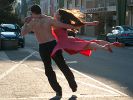Eye For Film >> Movies >> Pina (2011) Film Review
Pina
Reviewed by: Anne-Katrin Titze

If you have never seen any of Pina Bausch's mesmerising choreographies in the theatre, you are in for the treat of discovering a truly unique "voice" of dance.
Wim Wender's Pina, in 3D, is less a film about the late great master of dance theatre than for the mediator between cultures. If you know her work, you will be happy to revisit four of her pieces, Le Sacre du printemps (The Rite of Spring), Café Müller, Kontakthof, and Vollmond (Full Moon). Wenders weaves together parts of the stage productions, archival clips with Pina dancing, talking and smoking, short interviews with company members from the 36 years she headed the Tanztheater, and staged dance excerpts in and around Wuppertal, Germany, where her theatre company is located.

The effect of 3D on the dance performances is eerie - gauze curtains blow in your face, the dancers from all over the world invite you in. The documentary gives no introduction into Pina's career, no biographical information, no voice-over, but throws you into the movements. When the dancers talk to the camera, Wenders has opted not to reveal their names. Even though Pina invented another way to talk, the individuality of the dancers was never blurred, and everyone who ever enjoyed a Tanztheater performance will be thrilled to see red-headed Dominique Mercy, now co-artistic director of the company, look into a doll's house.
An insightful archival clip has Pina talking about the trouble she herself had in dancing Café Müller with her eyes closed. It made all the difference in the world if one looked straight ahead or downwards behind closed lids. These are the sorts of nuances explored. Bodies are positioned, dressed and undressed, childhood and old age become one, linear time disappears. "She saw something I didn't know myself," one of the dancers says of her process. A man in a tutu descends into a mine, a woman in a long floral evening dress dances with a leaf blower in the autumnal woods, a scene from The Complaint Of An Empress (1990), the only film Pina directed. "You always felt more than human," another dancer remarks.
Wenders, who is always big on local colour in his films (Paris, Texas (1984), Wings Of Desire (1987), Lisbon Story (1994), Until The End of the World (1991)) stages most of the dance performance snippets in the quirky locations of Wuppertal. The Schwebebahn, the fantastic hanging gondola reverse version of the Underground there, is the site of a lovely humorous piece featuring a man with cardboard rabbit ears and a woman with a pillow among the usual commuter crowd.
In Kontakthof, a group of men on one side of the stage and a group of women on the other try to make contact in a faded dance hall setting. They slide toward each other in their chairs fast, scratch their heads, move back again, wiggle their arms, all at once and each a little different. A song from the Twenties tells them in German not to take it all so hard while they are having fun. Pina staged this piece with many different dancers - in one incarnation, all the performers were teenagers over 14, in another, all were amateurs over 65 years old. Lilo Mangelsdorff's imaginative award winning 2002 documentary Ladies & Gentlemen Over 65 shows the rehearsal process led by Pina's dancers.
Wenders lets the movements flow from one age group into another, the costumes are the same, and so are the gestures. "Your fragility is your strength," a Japanese dancer recalls Pina telling her.
"That is veal," a dancer holds up a piece of meat before she puts it into the toes of her ballet shoes. Water is pouring on black rocks on the stage in Full Moon. Obstacles, like sand, stones, or rain are good, so is having a dance with a hippopotamus in a brook. The Kontakthof conga line (think: Barbara Stanwyck and Gary Cooper's professors in Howard Hawks' Ball of Fire, from1941) winds along a cliff at a sandy abyss near Wuppertal.
One of the dancers comments that Pina has not yet visited her in her dreams. What do our longings look like? What are we yearning for? At times the vague brand of Wenders' longing, a bit too heavy, too syrupy finds its way into this otherwise very powerful homage to the explorer of dance, who, herself, is always precise, never sentimental. Perhaps the closest endeavours by Wenders are his 1989 documentary Notebook On Cities And Clothes with Japanese fashion designer Yohji Yamamoto and his celebration of Ozu in Tokyo-Ga (1985).
In 1983, Pina Bausch played the role of the blind Principessa Lherimia in Federico Fellini's And The Ship Sails On, and in 2002, Pedro Almodóvar cast her in Talk To Her.
The last time I saw Pina in 4D, she was standing outside one of those smoker zones at Frankfurt airport on our way to Paris, waving the smoke inside the glass box. Ever since, I cannot pass by one of those unattractive compartments without thinking of her and her powers of transformation. If you see one dance film in your life, see this one with those 3D glasses.
Reviewed on: 20 Oct 2011
















